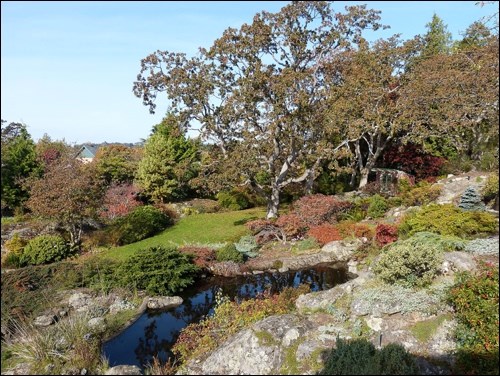A week in Victoria is easily filled with pleasant, diverse activities — historic guided walking tours, the “Goldrush” exhibit at the Royal Museum, boat cruises around the inner harbor, the Robert Bateman Gallery, sea food chowder and, of course, gardens. Victorian gardens (Zone 9a) are impossible to replicate on the Prairies. So if visiting, just sit back and enjoy. I did!
Although less well known than many, one of my favourites was the Abhkazi Garden. Sitting in only 1.4 acres, it is well worth a visit even in late October. Located in a quiet residential neighbourhood, it’s enclosed by a hornbean hedge and could be easily missed.
Its story began in the 1920s in Paris when the exiled Prince Nicholas Abkhazi from Georgia (once part of the Soviet Union, now an independent country) met Marjorie (Peggy) Pemberton-Carter who had been born in Shanghai, China. Then, during the Second World War, Nicholas and Peggy were interned in prisoner of war camps – Nicholas in Germany and Peggy in China. During her internment, Peggy kept a diary (as well as traveller’s cheques later used to purchase passage to San Francisco) hidden in a container of talcum powder.
After the war, she arrived in Victoria in December, 1945. She then purchased the property where the garden now stands, hired landscapers and, after receiving a letter from Nicholas (with whom she had lost contact), married the love of her life, all within a year. Peggy and Nicholas began to build the garden together, commissioning John Wade, a modernist architect, to design both the summerhouse and residence.
Peggy Abkhazi compared her garden to the Yangtze River or a Chinese scroll, gradually revealing a “sequence of views, mood and character” as it is unrolled, or as one follows the paths.
From the gate, visitors enter the rhododendron woodland garden in the lower part of the garden. Native Garry oaks (Quercus garryana) provide shade and shelter for the many species and cultivars of rhododendrons. Some were already 50 years old when first planted, and today are venerable specimens with gnarled twisting trunks of great beauty. Flowering from January to June, they are under-planted with naturalized spring-flowering bulbs, anemones, trillium, jack-in-the-pulpit and bleeding heart, followed by a succession of other woodland perennials such as ferns, hostas, tigridia and primroses.
Leaving the woodland garden, you emerge into the sunny open space of the south lawn and the stunning view of the enormous glaciated rock formations near the house around which the garden seems to flow. A mixed border, adjacent to the path, contains silver foliage plants that reflect the colour scheme of the rock and a 50-foot sweep of blue agapanthus that blooms in late summer. Three ponds, created in the natural depressions of the rock, provide a home for resident mallard ducks and turtles while reflecting the sky and nearby plantings. Alpines are planted to advantage on the rocks while deeper pockets of soil contain conifers, Japanese maples, azaleas and other flowering shrubs.
The summerhouse, built before the house was constructed as a venue for picnics, is the focal point as one walks up the gentle hill toward the northwest portion of the garden. The small porch and upper garden offer spectacular framed views of the Strait of Juan de Fuca and the Olympic Mountains. From the house terrace, visitors can visually retrace their steps and see almost the entire “scroll” of the garden unrolled.
After the deaths of Nicholas (1987, age 88) and Peggy (1994, age 92), the garden changed hands several times and was nearly lost to a residential development project. Luckily, since 2000, the Land Conservancy of British Columbia now owns the property. Admission is by donation. The house now holds a tearoom and small gift shop. (For directions, hours and more information: http://blog.conservancy.bc.ca/properties/vancouver-island-region/abkhazi-garden/)
— This column is provided courtesy of the Saskatchewan Perennial Society (www.saskperennial.ca; [email protected]; NEW www.facebook.com/saskperennial). Check out our Bulletin Board or Calendar for upcoming garden information sessions, workshops and tours: Nov. 25, 7:30 – An irreverent history of our gardens – from the Romans, Brits and French to the Prairies.




